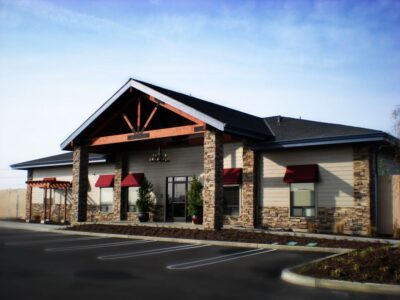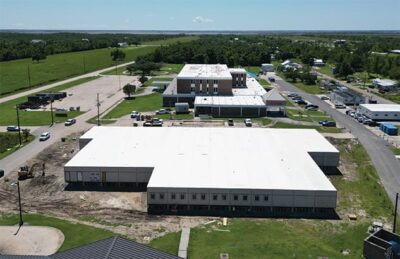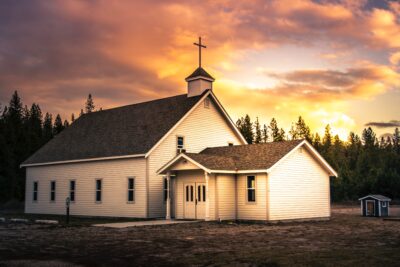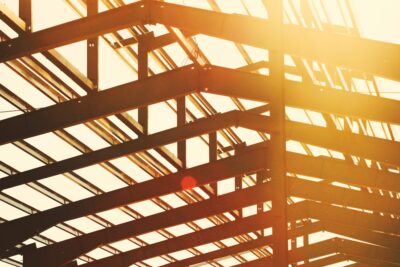SMM offers discounted previously leased modular buildings for a quick and affordable solution. If buying a portable building outright at this time isn’t feasible, the solution could be renting a portable building. With renting, you have the opportunity of finding an affordable modular building that fits your needs and budget. Renting quality portable buildings can be a wise choice for business owners, contractors, homeowners and municipalities.
Sustainable Modular Stories
Modular vs. Stick Built and A Case for the Future of Construction
Do you remember the first time you heard about modular construction? Do you remember what your initial reaction was? Did you think it was cheap, low quality, poor insulation, ugly, and not built to last? Did a double-wide trailer appear in your mind?
If you answered “yes” to any of the above, you’re not alone. The negative stigmas surrounding modular construction run rampant in the minds of most everyone, aside from those working in the modular construction industry.
One could point to these deeply held misconceptions and stigmas as a large reason why modular construction’s overall market share of the construction industry was 5.5% in 2021 despite its speed, environmentally friendly, versatile, and high-quality approach.
Aligning with these misconceptions, modular construction is rarely viewed as an alternative or substitute for stick-built construction. Many end users fail to realize that it does, in fact, achieve results that rival stick-built and, in many cases, surpass it. That’s because modular construction evolved from stick-built construction to meet a historical need for construction to be faster, more efficient, predictable, and shielded from external elements and harsh weather.
Types of Modular Construction
There are three types of modular construction as outlined by the Modular Building Institute and Sustainable Modular Management:
- Permanent Modular Construction – an innovative, sustainable construction delivery method utilizing offsite, lean manufacturing techniques to prefabricate single or multi-story whole building solutions to deliverable module sections.
- Relocatable Buildings – a partially or completely assembled building that complies with applicable codes or state regulations and is constructed in a building manufacturing facility using a modular construction process.
- Semi-Permanent – a building that could be relocated without a lot of additional costs with a design that allows for minimal additional costs for removal and reinstallation regarding how the mateline connections are managed. Installed on a permanent style stem wall foundation to allow for flush to grade entry that meets ADA access requirements with applied additional exterior architectural elements to give it a sense permanence.
It’s important to note that modular construction is not the same as “manufactured” – such as manufactured homes that most are familiar with. This is where many of the previously stated stigmas come from.
A Construction Method Dating Back to Ancient Rome
Many people believe that modular construction is a newer way of building, but it’s a construction method that dates back to ancient Rome. We’ve all heard the phrase “Rome wasn’t built in a day,” but it was built in less days than it could have taken because the Romans employed modular construction.
As we know, Rome was a walled city. Along the wall, there were forts much like the ones in the Great Wall of China. The forts featured four gates, a central ceremonial area, baths, and a kitchen. Larger more permanent forts had central headquarters, a chapel for storing sacred weapons, rows of slate-roofed barracks, storage granaries, cookhouses, and latrines with running water large enough to accommodate 20 men.
To build these forts, Roman armies carried them in prefabricated wall sections containing dovetail and cross-halving joints that allowed them to be quickly fitted together on site for instant defense.
Fast forward to the 1600s and there’s a report that refers to a disassembled wood paneled fishing house that was shipped by boat from England to the United States to Massachusetts. The modular building was used to house fishermen that had recently made their way to America and trusted English construction methods.
The Portable Colonial Cottage
However, the first modular building officially on record was built by Henry Manning in the 1800s, as Gilbert Herbert’s Journal Article for the Journal of the Society of Architectural Historians called The Portable Colonial Cottage recalls. Manning’s son was part of a small group of settlers arriving from Britain to make a new home in West Australia on the banks of the Swan River. Tents and flimsy huts built from local materials were no match for the harsh environment and conditions brought on by the weather. With survival on the line, Manning built a small, well-constructed wooden house in sections back in England and then it was packed for export and assembled with ease on site.
The little wooden house caught on with the other settlers and locals and became instrumental in protecting families from the weather and theft. These little wooden houses could hold up in the harsh environment because they weren’t built in it. The materials they were constructed with were of a higher quality than what could be sourced locally, and the environment they were constructed in was more predictable and fair-weathered than West Australia.
Back across the Pacific Ocean, modular construction was in high demand as the United States expanded westward. During the gold rush of 1849, more than 500 preassembled homes were shipped from factories in New York to California.
The First Modular Hospital
But it wasn’t just housing that modular construction was building back in the 1800s. Entire commercial modular buildings were being built as well. Well-known architect Isambard Kingdom Brunel designed a completely modular hospital at the height of the Crimean War in 1855 known as the Renkioi Hospital. It was designed, constructed, and shipped within five months and provided a facility for timely medical care during the conflict.
The Sears Modern Home Program
Fast forward to the turn of the 20th century and Sears, Roebuck, and Co. began selling prefabricated houses through its Sears Modern Home Program, geared towards the middle class and WWI veterans. Customers could order one of the 400 house plans from their catalog and receive it in easy-to-construct sections. All that was needed was land to place it on and labor to put it there. Once purchased by catalog, the building materials were shipped by train and ready to move into in as little as 90 days.
The Sears Modern Home Program was popular, and it helped build American neighborhoods as we know them today.
Advantages of Modular Construction
The advantages and efficiencies of modular construction that appeal to developers, general contractors, and builders can be summed up in three words: greener, faster, and smarter.
The Modular Building Institute outlines the main points around these three advantages best:
- Greener: The factory-controlled process generates less waste, creates fewer site disturbances and allows for tighter construction.
- Faster: Construction of modular buildings occurs simultaneously with site work, allowing projects to be completed in half the time of traditional construction.
- Smarter: Modular buildings are built with the same materials and to the same building codes and architectural specifications as traditional construction. Once assembled, they are virtually indistinguishable from their site-built counterparts.
With modular construction, site development and foundation work happen simultaneously with the construction of the building at the factory making it 30%-50% faster than traditional stick-built construction as shown in the image above.
But that’s just the start of a very long list of advantages that have brought the construction industry back to modular construction time and time again throughout history.
Flexibility
Flexibility in modular concept and speed of design are two major additional advantages of modular construction. When you work with a modular-minded architect, there’s a lot you can do with modular construction. Additionally, the speed of design for a modular building frequently gets overlooked. When constructing a stick-built structure, the plans tend to take a year or more while plans for a modular building take a matter of months
The Power in Repeatability
The repeatability of modular construction is also a significant advantage. Once the engineering is completed, a building can be repeated infinitely. Major developers have taken to modular construction for this exact reason. There is value in repeatability and the efficiency it creates is the intersection in which developers find significant cost savings. The efficiency in repeatability is marked by the site team not being nearly as busy, by focusing only on putting things together when the modular units arrive onsite.
Structurally Sound
Because modular construction happens offsite, another notable benefit of modular buildings is that they are more structurally sound. They are designed and engineered to withstand transport to the site, commonly along highways traveling upwards of 60 miles per hour and sealed to be weathertight when it arrives on site to protect everyone before finishes are completed.
Modular Construction – A First Responder of the COVID-19 Pandemic
The advantages of modular construction were made evidently clear during the COVID-19 Pandemic. Over the past few years, Sustainable Modular Management saw an uptick in the number of both relocatable and permanent health clinics and medical centers they were providing. Their modular construction solutions made it possible for these facilities to be delivered to a site and ready for use in as little as three days or built in less than two months and be fully operational. The ability to provide timely solutions empowered healthcare facilities and their workers to provide the testing and care people needed with the extra space to do so. In fact, modular building solutions offered space for care in rural and remote places where there wasn’t any before.
Another symptom of the COVID-19 Pandemic was the soaring costs of building materials while the need for housing was at an all-time high. People relocated and exercised their newfound location freedom due to the uptick in remote work. In Canada, Taylor witnessed developers being drawn to modular construction to meet the demands of the housing market with speed and avoid the high costs of materials as best they could.
Now, because there is such a demand for housing, many states, provinces, and countries are incentivizing the use of modular construction because of its speed, offering initiatives and grants for housing built within certain timelines.
The COVID-19 Pandemic has proven that the efficiency and speed are modular construction’s top two benefits and the reasons why developers and general contractors choose modular construction over stick built – especially during unpredictable and tumultuous times.
Modular Construction isn’t for Everyone – But Neither is Stick-Built Construction
To be fair, there are drawbacks of modular construction just as there are drawbacks of stick-built construction. Modular Construction is an ideal option for buildings that have lots of repeated design features such as apartments, hotel rooms, office buildings, and more. Factories can create lots of identical (or extremely similar) units efficiently and deliver them in a timely manner.
However, if time is not of the essence and achieving a truly unique look is top priority, stick-built construction might be the better option. The key benefits of stick-built construction are two-fold allowing for truly unique structures, and it is a well-understood, deeply ingrained process with long-established roles for stakeholders and workers.
However, there are some drawbacks of stick-built construction that John also points out including interrupted construction due to weather, change orders, and unforeseen site issues resulting in longer completions times. Most importantly, these drawbacks pose a far greater risk for cost overruns.
The modular construction industry’s main selling point is that it can seamlessly emulate a stick-built building, but historically speaking, modular construction was born out of a need for a better way to build. So, why does the practice of modular construction tout its ability to hide in the shadows of what it’s trying to be better than when it’s always been the future of construction?
The Future of Construction
There are a lot of things modular construction can do that stick-built can’t. Climate change, a continued housing crisis, and even future pandemics offer an opportunity for modular construction to show the world what it’s made of. It might be our only hope for sustainable building practices as land becomes scarcer and efforts to protect the planet become amplified.
Two particular aspects of modular construction that have the power to become highly attractive to environmentally conscious end-users is the smaller footprint and greener practices of modular construction. There are a few companies already in the business of appealing to environmentally conscious end-users. Pacific Mobile’s SAGE Classroom and SAGE Campus are alternative, healthier learning environments that are resource efficient and environmentally safe for inhabitants and the Earth.
Here are a few of the features and benefits that make Pacific Mobile Structures’ SAGE line the latest thinking in healthy learning environments with the best in green building practices:
- Improved HVAC systems incorporate energy recovery ventilation for healthier air, noise reduction, and energy conservation.
- More and bigger windows increase natural daylight and stimulate learning, while conserving electricity.
- Steel floor structures afford greater portability and longevity.
- Environmentally safe building materials don’t release toxins into the air.
This future of construction and design is already welcomed with open arms by millennials and now, Gen-Zer’s. These generations have embraced “van life” and tiny home living – simultaneously out of both necessity and out of a more environmentally mindful and conscientious lifestyle. These next generations could drive the future of construction towards modular.
Future Nostalgia
We hold the places where we live, work, learn, and gather near and dear to our hearts. It’s where we connect and create memories together, each of us living in our own experience and attaching that experience to the place it was experienced. When we look ahead and imagine futuristic versions of those places, many of us yearn for what we know or knew and become nostalgic for it to connect us with our experiences and memories.
At the same time, it’s important to acknowledge we’ll always have more standardized, traditional housing built by both modular and stick-built construction. City standards and requirements, HOAs, and people who simply just want to “fit in” will maintain it for the foreseeable future. However, if the modular construction industry can become curators of “future nostalgia,” it might just be what generations years from now long for.
Is Modular Construction Right for Your Project?
Every project is unique, and at the end of the day, only those closest to it know the project best. Modular construction might be the best option to get the job done, or it might not be. For developers, general contractors, builders, and even end users to make the best decision for their project, the modular construction industry must do their part in helping them to make the most informed decision. As an industry, we want more of the construction pie but also what’s best for each project.
The Next Chapter in the History of Modular Construction
“I feel very fortunate to be part of this industry for so many years,” says Garth Haakenson, President and CEO of Pacific Mobile Structures. “With the economic challenges we all face in material and labor costs and the environmental goals of reducing waste and energy use, modular construction has always been a very efficient method to build. The design and quality improvements over the years is something we all take a lot of pride in.”
“These past two years dealing with spiraling inflation and supply chain disruptions have forced many people to reevaluate how best to construct their project. Many people have turned toward modular construction. Given the advancements with manufacturing technologies such as robotics, CNC machining and the application of Lean processes, I think we’ll only continue to see more of that,” says Tom Coyle, Executive Vice President of Construction at Pacific Mobile Structures.
Throughout key moments in history, modular construction has always played a subtle but critical role. This moment in history is no different. We live in a time when the cost of living and the demand for housing are skyrocketing on the backdrop of an ever-looming climate crisis. When you think about it, the residential housing industry really hasn’t had any huge disrupters enter the space and truly change how we think about where we live. Additionally, performing commercial construction offsite is still not a widely accepted concept even though it improves efficiency, lowers costs, and results in less waste. The construction industry is where innovation is needed the most if we are going to make strides to solve the affordable housing crisis and reduce our impact on the planet for good.
This next chapter in the history of modular construction must be one in which end-users are educated and this construction method, dating back to Ancient Rome, finally steps out of the shadows to capture a larger share of a market in dire need of creativity, innovation, and a better way to build.
Now what comes to mind when you hear the words “modular construction?”
May 8, 2024
SMM Helps Build the Lady of the Sea Hospital
Sustainable Modular Management (SMM) helped to provide a temporary hospital for the Lady of the Sea’s. The temporary hospital is scheduled to open at the end of 2023. “This temporary hospital will bridge the gap of inpatient services while we continue to work toward building the new permanent hospital,” said Lloyd Guidry, Jr., Pharm.D., CEO of Lady of the Sea General Hospital.
Q. What services will be in the hospital?
A. With SMM’s help, the hospital is working diligently to bring back all of the services offered prior to Hurricane Ida. Inpatient care, ED, Lab, Radiology, Cardiopulmonary, Medical Records, and Business Services will be located at one site, making it convenient for patients.
- Relocated helipad is across the street by the current ER.
- Expanded healthcare services will include improved imaging, mammography, dexascan and MRI.
- Nutritional Services and meals will be available
- We will be expanding staffing and rehiring some staff who lost their position as a result of the hospital closure
- We will be bringing inpatient care back to the community with a 10 bed Med-Surg unit
- Patient privacy will be improved in the ED
- Improved work space for all hospital service
The temporary facility is constructed by Sustainable Modular Management and is a modular building that is able to withstand up to Category 4 (130-156 mph) hurricane winds. It covers over 28,000 square feet and offers a great healthcare facility for the community. As the original structure was damaged in a hurricane, this type of building will be important for the future. To learn more about this project, visit Lady of the Sea.
October 20, 2023
Child and Daycare Solutions: MODULAR DAYCARE Buildings
In 2022, 65% of families are comprised of two working parents, according to the Bureau of Labor Statistics. Modern times have called for modern solutions and the need for flexible to around-the-clock daycare options are in high demand. To meet this demand, modular daycare buildings and portable classrooms are a great solution to the increasing needs of working families.
Modular Daycare Centers
To meet the needs of working parents, many large companies are using modular buildings to create on-site, modular daycare centers to provide employees with the ability to have their children close and taken care of, all while continuing to work during business hours. Parents can see their children during lunch hours and breaks while offering extremely convenient pickups and drop-offs. This eliminates the stress of getting to pick-up time on time, and decreases the miles driven by not having to make an extra stop to and from work. This added benefit of on-site childcare is an incentive for employees and prospective applicants.
To offer this opportunity for working parents, the most convenient and low-cost option for employers is to create a space via modular construction. Quick turnarounds, cheaper construction prices, and endless options are top selling points. Modular daycare buildings can be easily constructed. Timelines are short, but still offer customization for selections like number of bathrooms, sinks, and square footage space. These buildings can also be easily equipped with the latest teaching technologies and outlets.
Our Classroom & Daycare Building Services
For more than 35 years, Sustainable Modular Management (SMM) has been dedicated to solving your construction needs with cost-efficient, time conscious, and sustainable solutions. We’re committed to assisting our customers navigate the modern, and changing, world. Our modular structures, including portable classrooms and modular daycare buildings, allow our clients to better serve their communities and employees. We take pride in crafting custom designs and we offer turnkey solutions. For more information on modular daycare building, modular classrooms, and portable classrooms, check out classroom offerings or contact us today.
August 4, 2023
3 Benefits of Modular Office Buildings
Modular construction is a building method that’s growing in popularity due to innovative and affordable solutions, as well as long-term flexibility options. Modular construction offices are a great solution to the ongoing labor shortage too, as traditional construction is both an expensive and time-consuming option. Below are 3 benefits that come with choosing a modular office system over traditional construction:
- Modular offices provide long-term flexibility
- Minimal disruption to your daily workflow
- High-quality construction
- Modular Offices Provide Long-Term Flexibility
Maybe your business is growing and/or constantly changing. Your office needs today may not be the same needs as tomorrow. Where will you be a year from now? What about 5 years from now?
Modular offices help future-proof your business by offering the flexibility you need to confidently grow or relocate your modular office, without worrying about extensive or expensive remodels, or having to find new office space in its entirety. Modular components come together quickly and with options of standard sizes or customization options, there’s always a selection that will fit your everchanging needs. When the time comes to either relocate your team or reconfigure your space, or even expand, modular offices help protect your investment by providing the flexibility to change.
- Minimal Disruption to Your Workflow
There’s nothing worse than trying to focus and work in a construction zone, or with constant disruptions. Loud noises plus the possibility of dust from drywall and construction can be incredibly bothersome. Modular offices help eliminate this disruption to your staff in a few ways:
- Modular offices are manufactured off-site. Instead of bringing the construction to you, modular office components are built to your specifications in an off-site facility. When completed, the modular office is shipped in its entirety, directly to the site.
- Installation is quick. Once completed and delivered, installation is fast and easy. We eliminate the interruptions by completing installation quickly with no mess and minimal labor time. The setup of modular offices are swift, helping your team get back to work quickly.
- High-Quality Construction
Modular construction delivers the same (maybe better!) quality as traditional construction. Modular office components are manufactured in a controlled and specialized environment. Unlike traditional construction, where lumber and other materials can sit out on the jobsite in rain and snow for days, every element of a modular office is stored and built in a sheltered environment to ensure you receive the highest possible quality modular office. Think: no water damage, no mold, no on-site issues.
Business owners and company managers are looking for better, innovative methods of construction that can minimize work disruptions and offer quick and affordable options. If a modular office system sounds like the answer to your office space needs, Sustainable Modular Management can help. Give our team a call at 972-619-7300, or contact us online today to receive a fast and free quote.
May 4, 2023
Pacific Mobile Structures Acquires Sustainable Modular Management
Pacific Mobile Structures has acquired Sustainable Modular Management (SMM) a fellow family-owned modular building company based in Frisco, Texas. The announcement comes after Garth Haakenson, President and CEO of Pacific Mobile Structures, and Nick Mackie, President and CEO of SMM began discussing the benefits of a combined effort in the very active modular construction markets earlier this year. As a 15-year-old company, SMM is managing over 700,000 square feet of leased modular building space spanning across a diverse client base in the federal government, healthcare, education, and energy markets.
Pacific Mobile Structures has acquired fellow family-owned modular building company, Sustainable Modular Management (SMM) located in Frisco, Texas.
March 1, 2023
The Future of Modular Construction: Looking Towards 2023
Construction is one of the world’s largest sectors and modular construction could save the US and European markets up to $22 Billion per year*. With construction prices being so high right now, this could potentially revive the market. Improvements are being made to figure out ways to make this type of construction more affordable, lighter, and more precise. This all leads to utilizing more environmentally friendly materials, lower prices, and increase productivity.
Modular buildings are growing in popularity and the number of ways they can be used is also expanding.
Modular buildings are growing in popularity and the number of ways they can be used is also expanding. They can now be used for almost anything a permanent structure can be used for, including offices, retail stores and restaurants. Their increasing popularity is due to several factors:
- They’re affordable. Modular construction much less than traditional building methods because it doesn’t require land preparation (such as grading), foundations or concrete slabs.
- They’re environmentally friendly. Since modular buildings are built off-site on a factory floor, they don’t pollute the environment with construction debris or create any noise pollution.
The construction industry lost millions due to the coronavirus pandemic.
The construction industry lost millions of dollars due to the coronavirus pandemic.
- Businesses that were affected included builders and contractors, as well as suppliers and distributors of plumbing equipment, electrical materials, building supplies and other products used in the construction industry.
- Construction companies also lost revenue on projects that had been planned but not yet started due to cancellations or postponements.
- Some builders reported job losses among their employees because they could not work while they were receiving treatment for illness or recovering from injury caused by the virus.
Modular construction is an affordable solution to the construction industry’s problems.
Modular construction is a great solution to the problems that face the construction industry. Modular construction is cheaper than traditional building methods, uses less materials and labor, and can be completed much faster than it would take to build using traditional methods.
Modular buildings can be used for almost anything a permanent structure can be used for. They are particularly useful when you want to put up a building quickly and cheaply, or if you temporary buildings for events. Modular buildings are often constructed on-site and put together piece by piece, allowing them to be built faster than traditional houses or commercial buildings that are built off-site and then shipped in multiple pieces.
Modular buildings can also be used as housing units, office space, retail stores/stores with offices attached—basically any kind of building where people need to work together or have access to living quarters within the same building.
Looking to 2023
Modular construction is the future of our industry. There are signs that modular construction could be a genuine market disruptor. Now is the perfect time for modular buildings because they can be built quickly while still providing high quality workmanship. They’re also environmentally friendly and cost effective compared with other forms of construction. After decades of slow change, 2023 sees modular construction disrupting and making a larger impact on the construction industry.
January 24, 2023
Modular Church & Religious Buildings
Is your church and/or congregation growing? Modular construction offers the perfect solution to meet your growing needs. Maybe you’re starting a new church? A cost-effective way to get the doors open quickly is to build quickly and safely.
There are so many uses for modular construction buildings in the religious community, covering a large range of uses including: fellowship halls, temples, classrooms, sanctuaries, food banks, administration offices, daycare/preschool facilities, bible study spaces, etc. Modular construction buildings offer a wide range of buildings to meet any type of need. What separates a modular church from other modular structures is that modular churches are specifically designed to suit the needs of a worshipping congregation. Such designs may include certain layouts, lighting arrangements, and acoustics that work together to create the ideal space for the community.
What is a Modular Church Building?
Modular church buildings, like all other modular buildings, are built off-site and are customized to fit certain needs. Once it is time to erect the building, these modular structures are put into place quickly and easily. This helps eliminate issues with cost, timelines, and physically being on-property in less-than-ideal weather conditions.
Why Modular Church Buildings?
Modular church buildings from Sustainable Modula Management are a smart and quick way to make more room for your congregation, all while adding new space(s) for the many services you provide.
Speed
One of top factors for choosing a modular church is speed. The setup time for modular churches is much shorter than the time it takes to construct a traditional building. The quick (and easier) construction process that comes with a modular church building can get you operating and serving your people on a much faster timeline than traditional construction. Compared to the modular construction process, traditional construction can take several months or even years in some cases.
High-Quality Standards
For more than 35 years, our experienced teams have worked one-on-one with diverse clients across multiple industries, including religious communities. We take pride in crafting our designs and we care about providing for our clients. We are skilled at creating consistent, high-quality buildings every time. We control all aspects of the process due to our off-site construction methods. Additionally, we personally handle the construction, delivery, and installation of modular sections at the project site.
Flexibility
Modular buildings tend to offer plenty of design customization options so that you know you’re getting precisely what you and your community need. Customization for modular churches will include different options for the interior elements of your building as well as the outdoor appearance. Different needs call for different features and our team can assist in the planning and designing.
Cost Savings
The main reason modular construction is cheaper is that it is quicker. We have shorter project completion times, we build in climate-controlled facilities, and thus have overall costs when compared to traditional construction processes.
At Sustainable Modular Management we can assist the entire way through, from initial planning and ideas, to design, project management, and financing. Call us today to explore our capabilities.
November 17, 2022
Advantages of Using Temporary Modular Buildings as Swing Spaces
Stuff happens. Offices relocate, businesses expand, disasters strike, and owners renovate. When changes happen, many companies find themselves in need of temporary worksite buildings or temporary offices to continue to get business done. Enter: Swing Spaces. A swing space is a temporary office environment that is used while current offices are being renovated, relocated, or if existing offices are deemed unworkable. Modular buildings as swing spaces are a popular option because they are affordable, easy to move and relocate, environmentally friendly, and offer durable and customizable spaces.
Temporary modular buildings are the perfect answer to the swing space dilemma. Modular buildings are constructed off-site and make it easy to move them wherever they are needed. Utilized as swing spaces, modular buildings help fill the gap when an extra, temporary, space is needed for a period of time. Common uses for swing spaces include:
- A Temporary Space During a Company Relocation
Relocations happen all the time. Whether it’s due to moving to a more favorable location, a need for more space due to booming business, or changing to a cheaper leased location, the move can disrupt operations and the need for office space become apparent. The possible loss in revenue or productivity is something owners want to avoid and offering a temporary space to work is important until the relocation is completed. A transitionary space, or swing space, via a modular building offers an area of workers to continue working, unaffected by the switch in location. Avoiding overlapping commercial leases is paramount to saving money and a modular building can be a much cheaper option as companies transition from one commercial space to another.
- Temporary Buildings During a Renovation or Unplanned Construction
Swing space to the rescue. As commercial buildings undergo construction or renovations, a temporary office for workers becomes essential. Whether you place a modular building in the parking lot, or on a completely different property, a swing space gives workers a comfortable environment to continue working. Maybe you’re a new company whose offices aren’t quire ready. A modular building can allow your business to be up and running before you’re able to move into your permanent offices. Commercial renovations usually have long timelines, depending on the size of the office, and a transitionary space is important for companies to continue operating on a normal schedule.
- When Disaster Strikes, Swing Spaces Save the Day
Disaster can strike anytime and anyone. Tornadoes, hurricanes, fire, and flood damage are events no one wants to deal with, but while we cannot prevent them, we can control our response. Disaster response can take months – from dealing with insurance to rebuilding – swing spaces allow companies to get back up and running in a timely manner. When offices are no longer safe and functional, a modular building can be used to keep operations going and to safely house employees. Many companies can’t wait out a long timeline and need to keep operating, modular buildings are a quick and cost-effective option.
Swing spaces, via modular buildings, can be incredible beneficial for companies. Closed and fully operational modular buildings can be customized for the individual needs and circumstances of each business. Whether to fill a gap in a renovation timeline, temporarily house employees during a natural disaster, or to get a company up and running before a permanent solution is completed, swing spaces are a versatile and cost-effective solution. Sustainable Modular Management has years of experience helping businesses and can provide numerous options for swing spaces. If your space is under construction, or undergoing a renovation, SMM can help identify a swing space solution for you. SMM also has buildings ready to go to help support post-Hurricane Ian. The recent hurricane in Florida will require temporary spaces to bridge the gap while communities rebuild.
October 6, 2022
Modular Classrooms are the Answer for Filling Schools’ Crucial Needs
In fall 2020, about 49.4 million students attended public schools in prekindergarten to grade 12 in the United States (according to the National Center for Education Statistics). As the population continues to increase or states see a shift in where people decide to live, the need for efficient and safe teaching spaces has been growing at a fast rate.
To accommodate the increase in students, some schools have decided to construct new buildings and classrooms, but even making minor changes to buildings can be costly and time-consuming. School schedules, also, only allow for small windows of construction time, usually during the summer, if the construction is an add-on project. Construction sites are not safe for students and can be distracting.
Modular classrooms are an effective solution to this problem as they are flexible, cost-effective, and can be constructed quickly within the constraints of a school schedule.
The Benefits of a Portable Classroom
Portable classrooms are a cost-effective way to adapt to classroom overcrowding, whether short-term or long-term, modular buildings offer a solution for schools and districts nation-wide. Depending on the needs, schools can rent or purchase prefab classrooms or administrative buildings.
Overcrowding
Portable classrooms can solve school district problems on tight time constraints:
- Shifting demographics and trying to predict enrollment numbers have become difficult for schools. Especially for areas experiencing exponential growth, like in the Dallas suburbs. The fluctuating and growing enrollment number of students demand flexible solutions to house all the staff, admin, and students. Renting or purchasing modular classrooms is a quick fix to prevent overcrowding. Modular buildings are a cost-effective and time-saving solution to provide teaching and admin spaces. Sustainable Modular Management offers a wide range of modular buildings that accommodate schools.
- With a very small window to allow for construction, schools can only carry out renovations or construction during summer break/vacation. The limited time is usually not enough time to complete renovations and get everything prepared before the first day of school. Using modular building solutions allows schools and districts to utilize other free periods including summer break, winter break, spring break, or other pauses in classroom teaching time.
- Many school districts don’t have the budgets for traditional add-on construction projects. Instead, schools can get fully equipped classrooms, administrative buildings, labs, etc. without having to pay astronomical prices for full-blown construction projects. Modular buildings offer options to purchase and/or lease.
Modular Adaptations and Versatility
Modern times call for modern capabilities. Schools are constantly adjusting to accommodate new teaching methods and requirements. Modular school buildings allow for the freedom to adjust. Traditional construction practices are rigid and don’t allow for the flexibility of altering spaces. Choosing modular and portable buildings allows for easy and cost-effective changes or even for complete overhauls of spaces.
Schools need versatility and modular classrooms offer flexibility on time, budget, and use of space. Choosing to go modular can allow for less disruption, increased flexibility, and quick solutions to many of the problems striking our public and private school systems.
August 25, 2022
Commercial Modular Construction: A Practical Choice for New Businesses
Starting a business is a thrilling but often intimidating endeavor, especially when considering the varied expenses related to building or leasing your own commercial space. In the last couple years, we’ve seen an explosion of new businesses being created as the “mass exodus” from 9-5 jobs continues. With that boom comes more entrepreneurs who are looking for a space of their own. Fortunately, modular construction buildings can help entrepreneurs build their own commercial building in the most economical way possible.
Commercial style Modular Buildings use advanced building systems that allow for cost-effective and faster construction. There are many ways new businesses can save in choosing commercial modular construction.
Cost of materials
Because materials are purchased by the factory in bulk and stocked inside a secured and climate-controlled facility, business owners can benefit from lower prices for materials, when compared to building brand new, on-site.
Energy-efficiency of the building
The materials used in multiple industry type applicationsfor modular buildings are premium-grade and precision-cut. This means gaps and drafts are less likely once the building is constructed. As a result, the entire building is more energy-efficient, decreasing energy expenditures. Building is mostly done off-site, and modular construction builders are able to lessen issues due to weather and can build with a higher quality of standards.
Shortened time of construction
Construction time is reduced with modular construction buildings and business owners can save on labor cost and can occupy the building sooner. The sooner a building can be occupied, the faster a business owner can start generating income. This means a faster ROI.
To find out more about the benefits of commercial modular construction, contact Sustainable Modular Management.
June 11, 2022










